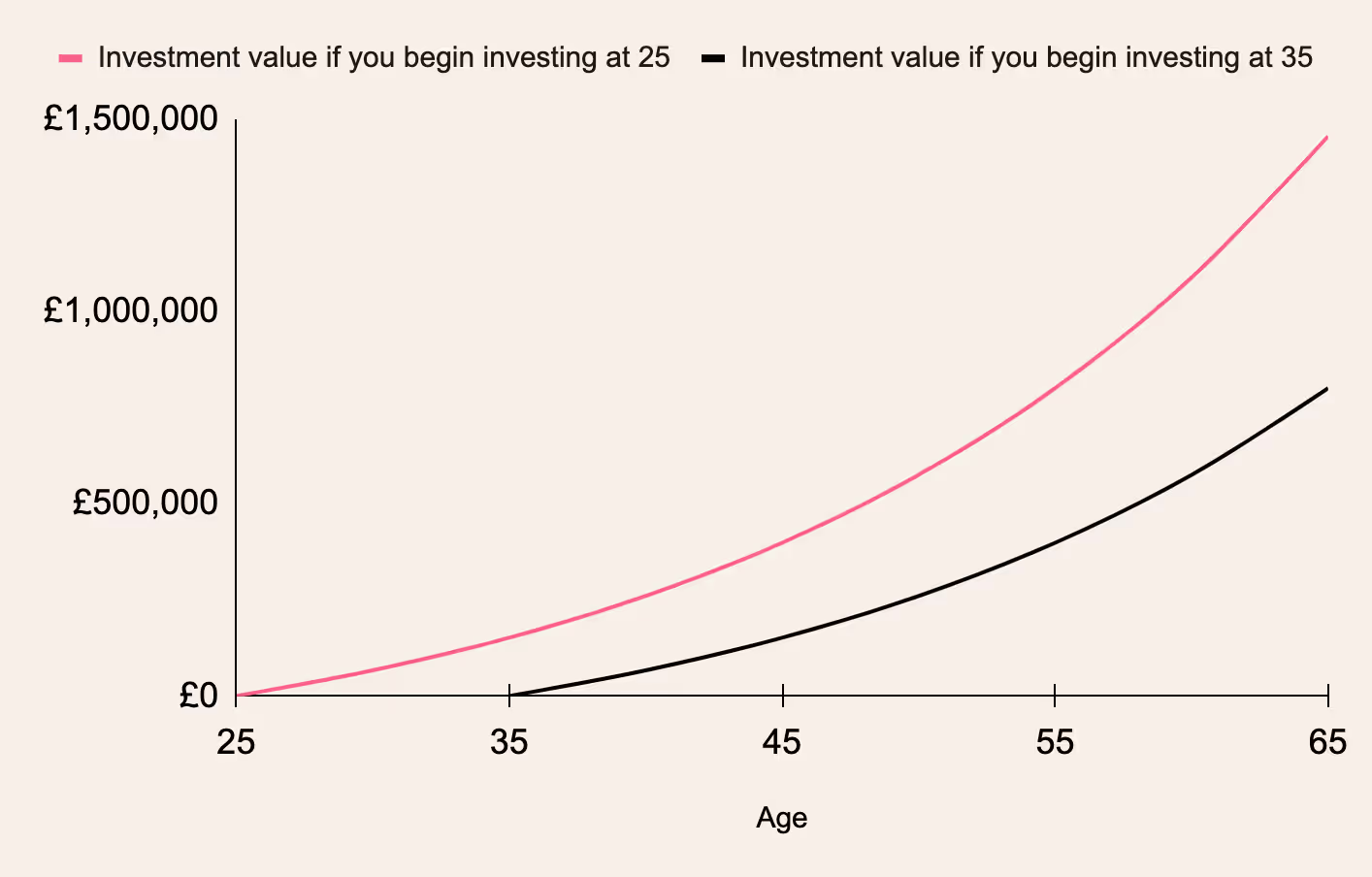If you’re thinking about making the decision to start investing, congratulations. It’s a big step in the right direction to grow your wealth for the long term. But, before you start putting your money to work, you’ll want to understand how to do things properly.
The good news is, we have plenty of resources available to help, including our best investments for beginners guide.
Tons of Freetrade investors know what it’s like to be an investor at the start of their journey. Our recent surveys have shown that roughly 50% of Freetrade users were investing for the first time.
What it means to invest and why you should think about starting
In case you’re looking for a refresher or you’re completely new to the world of investing, here’s an overview of what’s involved.
So, why invest?
The basic concept is to buy something today that you think can be sold for more in future.
Investing itself is a tool you can use in an attempt to grow your money. When you’re putting your money to work in the stock market, this basically involves deploying your capital into companies.
When you become an investor, you own a piece of those companies by buying shares and becoming a shareholder.
In an ideal world, those businesses will make a profit. If this happens, the value of the company should rise and its share price might grow. The company might reward shareholders with a dividend too.
Dividends and share price growth are never guaranteed though. That’s why it’s always drummed home that you may get out less than what you put in when you start investing.
It’s not a foolproof way to make money. Not all investments will be lucrative, and the stock market tends to rise in the long run, but there will be ups and downs in the short term. But, modern technology and access to markets now provide an accessible way for anyone to potentially build wealth with investments.
At what age can you start investing in the UK?
With most share dealing accounts, anyone over the age of 18 can open an account and start investing.
However, there are ways to begin investing at a younger age. From the age of 16, it’s possible to open a custodial account with the approval of a parent or guardian. Not all platforms offer this and there might be restrictions on what you’re actually able to do as a minor so be sure to check first.
How much do you need to start investing?
Not as much as you might think.
There’s a general misconception surrounding investing that you need deep pockets and piles of cash to start. That’s simply not true.
With the Freetrade app, you can start investing with as little as £2. So, investing can be affordable for just about everyone if you’re using the right platform.
Of course, if you’re looking to invest £1,000 or an even bigger sum like £10,000, this could open up more avenues. But thanks to fractional shares, on Freetrade you can own a portion of a share for much less than its actual price. If the full pie is a full share, a fractional share is a slice. And sometimes that’s all your appetite needs.
So if you want to invest in a company but the share price is higher than you’d like to spend, you can just buy a fractional share instead.
All the more proof you really don’t need lots of money to start investing.
Investing with a little amount of money
Some people know they want to start investing but get put off by the false notion that there’s no point if they only have a little bit of money to invest.
In reality, even small investments can add up and grow over time. There’s no certainty that investments will grow, but consistency can be crucial. Time in the market is often your best asset.
Investing as soon as you can afford to, even if it’s only a little, will give you the best chance of seeing your returns blossom over the long term using the magic of compound interest.
Compounding returns is when the interest on your principal investment also earns interest, creating a snowball effect.
It’s one of the greatest benefits of being a long-term investor. And the longer you can give it, the more powerful compounding becomes.
The chart below shows compounding in action. Imagine you have two pots of £1,000 to invest. If you were to add an additional £1,000 every year and each pot were to grow at 5% annually, starting earlier helps that pot grow to a much bigger size. It’s time, not extra cash that makes the difference.

Please note this chart is just an example and is not a guide to realistic returns. Continuous 5% growth is not realistic, some years it could be more and some years less. Investments can rise and fall in value, so you may get back less than originally invested.
Different ways to start investing
After making the choice to start investing, when you’re trying to decide which stocks to invest your money into it can feel like information overload.
To give you some inspiration in a clear and easy way to grasp, below is a breakdown of some popular ways to start investing.
Investing in the stock market
Investing for the long term in stocks is one of the most tried and tested ways to attempt to grow your savings.
The most important thing to remember is that everyone has their own goals and unique financial circumstances. These, along with your tolerance for investment risk and time horizon, should inform the mix of assets in your portfolio.
Our resource hub for investing in the stock market might be able to help make that blend a bit clearer for you and our guide on how to invest in stocks is a great start for first-time investors. And if you are still unsure of how to pick investments, speak to a qualified financial advisor.
Once you know what your investment priorities are, there are plenty of options to choose from. For instance, you could invest in tech stocks or buy ETFs that contain a basket of investments.
Alternatively, you might want to look into a niche like vegan stocks. Or maybe you simply decide to buy popular UK shares. There are many choices to suit every type of investor. For a more in-depth explanation of the basics, you can check out our guide on how to invest in stocks too.
Who stock market investing is best for
Investing requires patience and a commitment to a long-term investing strategy. When you’re in it for the long haul, it’s not about checking your portfolio every day for the fluctuations and ups and downs. You have to be able to handle a certain level of risk and volatility too, and to know the market will have good days and bad days as well. But in the long run, the market tends to go up as good companies create value and bad ones fall by the wayside.
Risks of stock market investing
Some companies perform better than others. Certain stocks will grow for decades, others will plummet and possibly never recover.
Regardless of whether a stock performs well or poorly in the long run, there are likely to be plenty of ups and downs along the way.
There is the risk that you’d lock in losses if you sell your stocks during a period of volatility when the price dips. So you need a steady hand and a cool head to make it through any turbulence.
How to start investing in the stock market
Everyone’s process will be different, but here are some simple steps to follow if you want to begin investing in the stock market:
- Choose an investment account.
- Create a plan or investing strategy.
- Research the stocks that fit in well with your goals, time horizon, and risk appetite.
- Deposit funds into your account.
- Select how much you’d like to invest and buy the stocks.
When should you start investing in stocks?
Provided you’ve taken the time to look at the rest of your finances and decided that investing is what you want to do, the sooner the better.
Having time on your side has plenty of benefits:
- The ability to ride out volatile periods.
- It gives your investments the best opportunity to mature and grow.
- More breathing room for mistakes.
- The potential to benefit from compounding returns.
- A longer time frame means you’re less likely to make rash, knee-jerk decisions.
Invest by trading stocks in the UK
If you’re interested in growing your money by putting your cash to work, investing in stocks with a long-term mindset is one of the best ways to get there.
Who trading stocks is best for
When it comes to trading, it’s best to avoid things like day trading. And instead, focus on the possible long-term returns of buying and selling stocks, ideally with at least a five-year time horizon.
Risks of trading stocks
Share prices can fluctuate quite a lot, especially in the short term. When you’re trading in and out of stocks quickly, you’re exposing yourself to these movements.
Employing a long-term trading strategy will improve your chances of investing successfully as the markets typically trend upwards in the long run. It can sometimes take a while before an investment fully plays out, so time in the market can be your friend.
If you attempt to trade on a shorter time frame, you could be unnecessarily exposing yourself to higher price volatility.
Trading successfully at the exact time for that is extremely difficult to pull off. You can reduce your risk by becoming a sensible trader, thinking in periods of years and not days.
Attempting to predict price movements in the near future can lead to greater losses than if you were a long-term ‘buy and hold’ investor.
That’s because instead of buying shares in companies with solid fundamentals and good long-term prospects, you’re banking on wide swings in a company’s share price, which don’t always have a rhyme or reason. That’s why analysing and using methods to value stocks is a much more reliable way of securing returns instead.
Invest in property and real estate
Investing in property or real estate is an option for those who like the idea of owning physical assets. Though buying real estate is expensive. Odds are, a house purchase will be one of the priciest things you purchase in your life.
Who property and real estate investing is best for
People who prefer the idea of owning bricks and mortar and are willing to take on the extra costs involved in a purchase.
One of the main goals of property investment is often to generate a positive cash flow with a rental yield. Rents have historically tracked upwards over time, and the average rent in the UK is now up 10.8% from last year.
The other motivation behind a property investment is to sell after capital appreciation. But, the process of buying and selling houses can be fairly lengthy, complex, and incur lots of additional costs.
Risks of property investments
Like the stock market, the real estate market is very varied and made up of both good and bad investments.
The real estate market marches to the beat of its own drum and comes with specific risks that may not apply to other investments.
It’s a sector that can be heavily influenced by government policies and tax regulations. Property investments also tend to be fairly illiquid, income can fluctuate, and there can be a lot of costs involved.
How to start investing in property
If you want to own real estate but don’t want the hassle of owning physical property, you might want to explore investing in a REIT (real estate investment trust).
Buying property can often require lots of upfront capital. Whereas, investing in REIT stocks can be done with a small initial investment. And, you don’t get the headaches of having to personally look after and supervise a property.
How do you make money with REITs?
The idea with REITs is that a building, or a whole portfolio of properties, is rented or leased out.
Individuals and companies renting these spaces pay fees for using the property.
The REIT that owns and manages the properties is required to pay at least 90% of the earned rental income out to the investors who own shares.
This payment usually comes in the form of a dividend, which you can keep as income or reinvest. That’s why investors looking to buy dividend stocks will often consider the most popular REITs.
Investing in cryptocurrency
Over the last decade, lots of money has been flowing into cryptocurrencies, particularly Bitcoin (BTC).
One of the major differences between stocks and cryptocurrencies is that the latter doesn’t actually make money or generate a return itself.
That’s a big reason behind an ongoing regulatory battle in the US discussing whether they should or shouldn’t be thought of as securities.
But you don’t necessarily have to hold individual cryptocurrencies to invest indirectly. It’s also worth keeping in mind that you can buy shares in crypto companies or invest in the metaverse, which is often linked to crypto too.
Crypto investing is best for…
People who have an extremely high tolerance for risk and volatility, are interested in the idea of digital asset ownership and have at least some technical understanding of how these projects work.
Remember that crypto invites speculation when it isn’t being used as a currency. Stocks, on the other hand, are reflective of real companies with earnings, revenue, and ideally profits. That means they’re worthy of analysis, you’re not just reading tea leaves.
Risks of crypto investing
How long do you have? We’ll try and keep this short and sweet. Cryptocurrency investing is inherently risky because there’s no regulation and most projects are decentralised, so no one controls them.
There are no legitimate custodians or crypto banks. So it’s up to you to protect and store your crypto assets. You can lose everything due to hacking, failure of an exchange, or simply misplacing your passwords and losing access to your tokens.
There’s still a poor guy in Wales searching through landfills trying to find a discarded hard drive containing roughly $165m worth of Bitcoin. Ouch.
Things to consider before you start investing
As mentioned, investing can be a useful wealth-building tool. But it also comes with risks and considerations that wouldn’t apply to something like a savings account at a bank.
So, before you start investing, it’s important you’ve done a thorough analysis of your finances, and made sure that you’re prepared to keep that money tucked away.
Is investing the right thing for you?
Investing isn’t for everyone.
Although, it’s important to realise you may already be investing through your pension and not realise it. But, unless you’re using a SIPP (self-invested personal pension), the investment decisions are probably not completely down to you.
Investing does carry risks and some people just aren’t comfortable with the responsibility of managing things.
Or, you might hate the idea of losing money so much that growing your wealth just doesn’t interest you.
Investing can be an excellent tool, but for the most part, it shouldn’t be exciting. If you’re looking for thrills, head to Alton Towers instead.
What is your risk tolerance?
Everyone’s appetite for risk is different.
Sometimes people forget this when it comes to investing. If you’re a particularly risk-averse person, picking high-risk investments may not be your cup of tea
Similarly, if you can stomach the risks and the volatility, you might be willing and able to take some risks with your investments with the aim of reaching higher rewards.
There can be ways to invest that suit every type of person, no matter how much you love or hate the idea of risk.
The most important thing is to make sure you pick stocks that match your individual beliefs around investment risk, not anyone else’s.
Think about your investing goals and timeframe
Understanding these aspects will feed into everything else.
Having specific goals and an idea about how long you want to invest for will help you make better decisions about what investments to pick.
It will also allow you to get better clarity on what stocks fit within your comfort zone of risk, and the investing approach you want to take.
Your goals and your timeframe will change and evolve, so it's okay to have some flexibility. It’s perfectly fine to stray from your original plans over the years, and in fact, you should if the facts change.
If an investment case that used to look sound no longer appears so, you need to re-assess and decide how to react accordingly. It’s not about sticking to the same investment thesis forever, it’s about reacting and responding if the information and your circumstances change.
At the same time, not overreacting at every ebb and flow in the market too. Ideally, you want to strike a healthy balance.
What investment platform should you use?
Again, this is all about finding a platform that suits your investing priorities.
Ideally, you want to use a platform that:
- Has low platform costs and minimal fees for buying or selling investments.
- Gives you access to a wide range of stocks and shares.
- Is easy to use and won’t overwhelm you with jargon.
- Allows you the option to use tax-efficient accounts like an ISA or SIPP.
Investment costs and fees
Investment charges can be a silent killer of wealth and will really eat into your potential returns.
Similar to the fact that small amounts invested can make a huge difference over time due to compounding, the same can be said for costs.
If you’re paying a high initial fee for a little investment, you’re already starting off with a negative return.
For platforms that charge an ongoing percentage fee based on your holdings, these can also snowball to become a significant chunk over your investing lifetime.
The benefits of commission-free investing
Commission-free trading is incredibly beneficial for retail investors because it’s one less cost to worry about. It’s the core tenet of Freetrade’s belief that investing should be accessible and affordable to everyone. So when you use the Freetrade app, commission-free trading means you won’t pay fees when you buy or sell shares. Remember though, there might be other charges if your ETF or investment trust has a fee, or you buy foreign stocks that come with a foreign exchange charge.
Not only will keeping costs low help your investment performance over the long term, but it’s also going to reduce the pressure on your decision-making.
It gives you the breathing room to make a mistake and then rectify it, or change your strategy without the burden of a hefty fee to weigh down your portfolio.
Types of investment accounts
When you start investing, once you’ve chosen a platform, you’ll also need to decide what type of account to use. The main options will be:
- General investment account (GIA)
- Stocks and shares individual savings account (ISA)
- Self-invested personal pension (SIPP)
A GIA is free to set up and use with Freetrade. But, you may have to pay dividend or capital gains tax (CGT) on any returns, depending on if you go over your allowance. That’s why it’s normally worth just starting with an ISA or SIPP from the start, so you don’t have to worry about paying taxes on your returns. You can read our guide to find out more about how your shares are taxed.
Tax-efficient accounts for investing
Right from the get-go, it can be worth using a tax-efficient account to hold your stocks when you decide to start investing. Even if you’re not likely to go over your allotted annual allowance for capital gains, the power of compounding can get you there faster than you might think.
The two most common accounts include the SIPP and stocks and shares ISA.
Currently, a stocks and shares ISA will allow you to put in up to £20,000 each tax year. What’s great is that this tax wrapper protects your returns as they grow. And, once you decide to start withdrawing funds from your portfolio, you don’t pay any income tax.
A SIPP is slightly different. This is a pension account that you can’t access until you’re at least 55, likely rising to 57 in 2028. But, money held here also grows free from a tax bill. And, you also get tax relief, which means a boost on top of your investment from the government.
Most savers get at least 20% (basic rate income tax) in tax relief and with a SIPP, this is added directly into your account.
If you add £80 to your SIPP, we'll collect £20 (i.e 20% tax relief) from the government and add it to your Freetrade SIPP account. Making your total pension contribution £100.
You can put in up to £40,000, or enough to match your salary (whichever is lower) and can put in more if you want to, it just won’t attract the same tax relief. Unlike ISAs though, withdrawals may be subject to tax once you retire and start using the funds.
Diversify your investments
No matter what route you decide to take as an investor, diversification is crucial to your success.
Using a diverse selection of stocks or investments will give you the best chance of prospering and surviving every type of economic climate. That’s because you’re investing in different areas, industries or companies that should react differently to any changes in the market.
It’s important to expect the unexpected. But you don’t want to spend your whole time as an investor on tenterhooks. That’s why diversification will allow you to sleep easy at night.
A diversified portfolio can be a great way to set a solid foundation. One that will help you tap into the leading sectors and themes when times are good, and minimise your losses when the market turns sour.
No one has a crystal ball or knows exactly what’s going to happen. Creating a portfolio with a healthy level of diversification is a great way to buffer for the unexpected when you start investing.
Should you start investing?
Only you can decide this.
Investing can be extremely rewarding, but there’s plenty to consider and think about before you jump into the market.
If you’re prepared, understand how to start investing sensibly, and the rest of your finances are looking healthy, you’re venturing into investing in stocks with open eyes and realistic expectations.

Build your financial knowledge and be in a better position to grow your wealth. We offer a wide range of financial content and guides to help you get the insight you need. For example, learn how to invest in stocks if you are a beginner, how to make the most of your savings with ISA rules or how much you need to save for retirement.
When you invest, your capital is at risk. The value of your portfolio can go down as well as up and you may get back less than you invest. This should not be read as personal investment advice and individual investors should make their own decisions or seek independent advice. Past performance is not a reliable indicator of future results.If you are unsure whether a product is right for you, you should contact a qualified financial advisor.Freetrade is a trading name of Freetrade Limited, which is a member firm of the London Stock Exchange and is authorised and regulated by the Financial Conduct Authority. Registered in England and Wales (no. 09797821).

.avif)




.avif)





